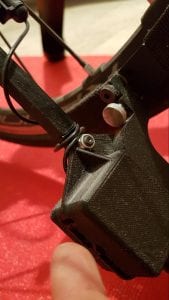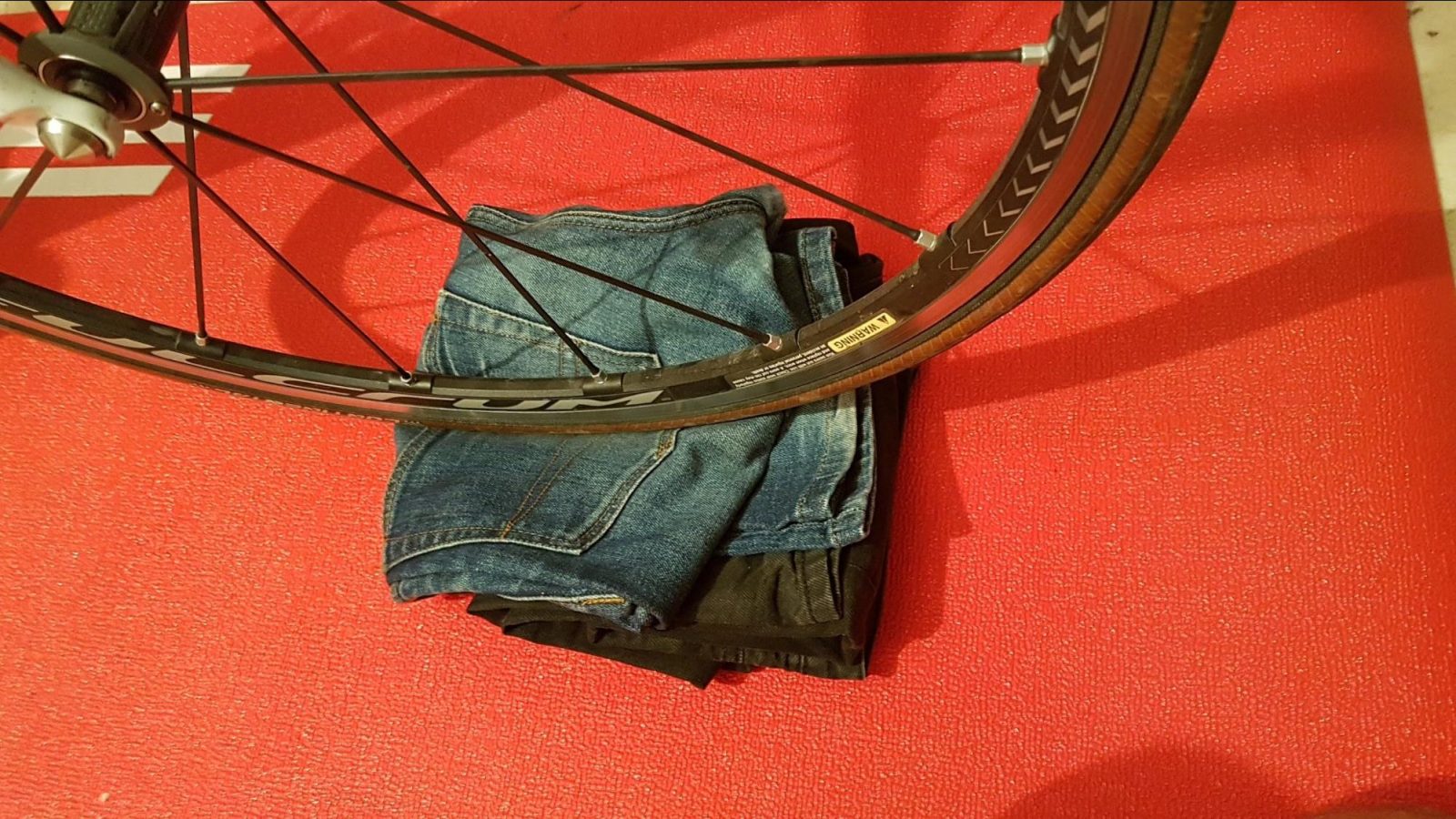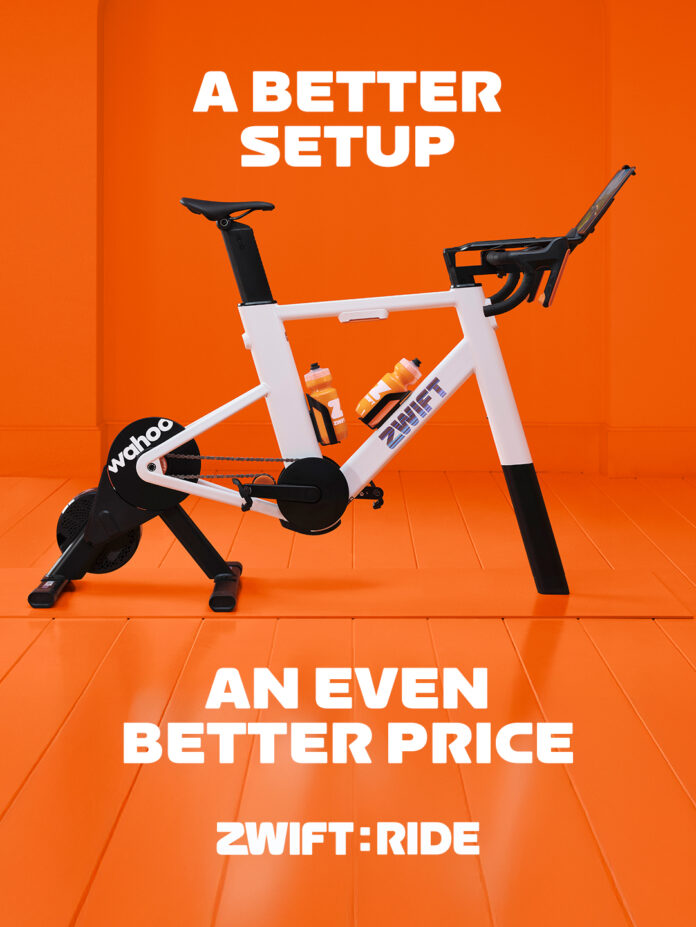The Stac Zero trainer (available from Clevertraining.com) sits in a rather unique spot of the market. To this date, it’s the only crowd-funded project trainer that successfully made it to the market. (It’s also the only crowdfunding project that I supported which shipped on time.) It’s a wheel-on trainer, but there’s no contact between the wheel and the trainer. As a result, it could be the ultimate sound-free trainer. In the version I own, it’s also one of the cheapest trainers on the market with a built-in power meter. All of that is greatly summarized by DC Rainmaker’s hands-on of the trainer in summer 2016.
After reading his hands-on, it took me only a day to cease my participation in the disastrous LIMITS power meter campaign. Based on my personal experience, I have since recommended this trainer many times. This review summarizes my perspective one year later.

To date, I haven’t fully understood the naming of the Stac Zero trainer. It’s possible that they stacked up some of their early prototypes and figured that they really don’t take any space. Really: this trainer has been sitting in a tiny niche all summer.
You could store it in a Japanese container apartment. You could take it in a trolley and fly with it around the globe. Just for the fun of it, I fitted it in a trolley that I use on EasyJet and Ryanair flights. Read: yes, it fits in your hand luggage. I’m not sure it would pass the security check, however.
Setup
This review won’t include an unboxing, because it’s my second season with the trainer. Instead, here’s the un-storing in a short series of photos.
(1) You fold out the legs. Pay attention when you carry it not to get your fingers caught between them. It can hurt. Ask my girlfriend how mad she was with me.
(2) You put it on the floor, open the quick-release of the magnets (not strictly necessary) and increase the gap between the two bits that will hold your frame. They are able to hold the bike on any quick-release skewer, but they also work with alternative axles: this season, I forgot to exchange my Pitlock with a quick-release and only noticed it after the first ride.
(3) You put your bike at about the right position and then tighten those screws. Do it symmetrically. I find it a bit difficult to decide when I have tightened it enough. Usually, I tighten generously, then give it a try and untighten them a bit if I hear tension in the frame. The broken piece on the trainer was damaged on delivery. It didn’t like the long flight, apparently. After the initial batch, the Stac Zero guys improved their packaging, however, so this shouldn’t happen again.
Reading these three steps takes more time than doing any of this. Anyways.
(4) Next you pull these little screws on the side of each magnet. That allows you to rotate the magnet and bring it parallel to the rim. Your rim needs to have an alloy surface, because carbon is not magnetic. Once they are in the right position, the magnets neatly fit back. Almost neatly in my case. One of the two seems to have escaped the eyes of quality control and doesn’t fit in all the way; but the magnets are stable.
Including taking pictures, switching between different rooms, rolling out the floor mat and setting up the sweat catcher, this took me five minutes and zero tools. However, one of Stac Zero’s weaknesses is the setup repeatability. You use a quick lever to adjust the distance between the magnet and the rim. Without any aid, getting the same exact distance on two different occasions takes a bit of luck and guess work. Even if your preferred distance is not pre-set, this tool helps massively. Variations in the setup (i.e. how much more or less watt I’d pedal in the same gear at the same cadence) have not been higher than 10w, in my experience.
If, for whatever reason (e.g. different wheel size), you need to adjust the position of not just the magnets, but of the whole resistance unit, you can do this with a regular Allen key. It takes loosening and tightening two screws. Obviously, that also makes the trainer very maintenance friendly.


The power meter needs three AA batteries to operate. I had to change them only once since owning the trainer, coincidentally a week ago. The battery housing is the third bit of the trainer that gave away the prototype character of the Stac Zero concept. It was a bit finicky to get the battery holder to exchange the batteries out of the housing, because there is very little space. I keep this in past tense, because the company has updated the battery since. It’s now a Li-Ion battery that is recharged via USB.
One more thing: On the Stac, the rear wheel sits 5cm above the floor. Hence, the bike might lean forward. I found that uncomfortable. I had been too lazy to get my old Elite front wheel stand from the basement, so I just took two pairs of broken jeans. Conveniently, I had also been too lazy to throw them away yet. They even give a more realistic feel to the whole thing. I should make it a Kickstarter, maybe. But on Indiegogo.
Silence
Stac Zero claims to be the most silent trainer on the market. DC Rainmaker agreed on that. I originally made some audio samples myself to demonstrate it. Here are five audio samples:
Cycling at 120w:
Cycling at 120w, in the background you can hear the GCN show on the weak speakers of a Microsoft Surface Pro 3:
Cycling at 200w:
Cycling at 200w, again with the GCN show:
Cycling at 200w, while I’m talking in the phone, no more or less loud than usual:
My face was 30cm on top of the phone and I was talking right into it. The computer was 50cm on the side and not directed at the phone. The phone was mounted on the handlebar. I haven’t cleaned my drive train since July and gave it fresh grease for the last time in September. Because, you know… I was a bit lazy.
There’s still sound from the bike. But how much really? I also add this video, courtesy of the Triathlon Magazine Canada. They compared the sound from the Stac Zero with the one from a Blackburn Tech Magic 5 and a Kurt Kinetic Rock and Roll, and they add a decibel meter. Oddly, they find that the Kurt is as silent as the Stac Zero. What’s going on here?
https://www.youtube.com/watch?v=HIO7rMYcc4Uab
On the Stac Zero, the only sound generated is from the drive train. As you pedal faster, there will be more noise. On the Kurt, sound comes from the drive train and from the resistance unit. Also their noise levels increase with speed. However, it is possible that the rear wheel spins faster on the Stac Zero at a given power output. Hence, for 200w, you’d have more noise from the drive train. The noise from the resistance unit will, at lower power levels, be more silent than the noise from the drive train. Only at higher power levels, it might start to dominate. To conclude: the Stac Zero is built for silence, but how audible the advantage is depends on your power profile. You’ll definitely never hear any trainer sound. No high-pitched buzzing.
Sweat
When Stac Zero launched their campaign, they faced some skepticism about their claimed resistance power. They say that the trainer could build up to 2000w resistance. I’m not the right person to formally test it out, as I’m not Marcel Kittel. My maximum 5s power to this date is about 650w (about a week ago). I’m riding a 50/34 and 12/30 compact setup. At that level, I was in my highest gear, pushing out a cadence of about 100rpm (I’m talking about 5s averages.) Consider that a better rider might do 110rpm on a 53/11 gearing. You could expect (or calculate) that without changing the distance of the magnets (i.e. changing the default resistance of the trainer), this guy might push out about 20-25% more peak power.
There was no big movement in the trainer, but I didn’t dare do it out of the saddle. Last season, I had done a similar sprint with less tension on the frame and had found it to be too unstable. When I had gone out of the saddle, the trainer tilted a bit and I was afraid it would flip over. That limits peak power; a wider base could be a remedy, and I can imagine various custom hacks to achieve that. A stronger rider will also induce less wobble at higher power, because his body will be more stable.
This year, apparently I have more tension on the frame and things are more stable. When I go out of the saddle (e.g. during climbing), I do not have any issues with the wheel touching the magnets (a recurring issue of last year). However, with my current FTP at 201w, I can use my 50/12 in sprint intervals. A better trained rider might want to decrease the distance between the rim and the magnet. I’m currently using a setting that’s slightly easier than the second level (of three levels) of the distance calibration tool they provide. In other words: I’m not exploiting the Stac Zero yet for real.
To sum it up, let’s assume you’re able to produce about three times your FTP during a sprint effort: If your FTP does not exceed 250w, you’ll be fine with a 50/12 setup and the Stac Zero. Beyond that, you might want to switch to a 53/11, though I assume you’d already have it on your bike at that level. With 53/11, I speculate that 1300-1400w comes close to the maximum power that the Stac Zero can take under realistic conditions. That matches also with the indications on Clevertraining.com. Unfortunately, I can’t test it out.
I never had wrong power readings from the trainer. Any dropouts that I encountered on Zwift were WiFi related. The ANT+ connection works flawless. I use it with the [amazon_textlink asin=’B004YJSD20′ text=’Suunto Movestick Mini’ template=’ProductLink’ store=’zwif-20′ marketplace=’US’ link_id=’40bef2e5-e0f3-11e7-937c-b3e7d41f55e9′].
Swag
The Stac Zero is a clever trainer, but not a smart trainer. The resistance unit is not controllable. You need to set your resistance level before the ride. When they entered the market, the brains behind this trainer indicated that a smart resistance unit might be on the way for the 2017 season. They presented a fully functional prototype in fall 2017 at Interbike, but suggested that it would very likely not go on sale before the 2018 season – after beta-testing. That shouldn’t hold you back from buying the trainer if you like the concept. The prototype is compatible with the first generation trainer. The team has indicated that the final product shall be compatible as well, so an upgrade is possible. For details on this, please go and visit DC Rainmaker. After you finished reading the rest of this article. And, of course, come back.
The trainer exists in a version with and without power meter. I do not have a second power meter to compare against. Or, I do have one lying around… but that one is a LIMITS, and that’s as good as not comparing it to a power meter at all. For what it’s worth, below is a big batch of comparisons between the two from last January. The take-away: the Stac Zero power meter does not need a warm-up time, operates consistently, reacts immediately to variations in power, and has no weird power spikes or dropouts. Except when I stop because I forgot to fill the bottle. Or to turn on the fan. Or to switch the light off. Below is a sample chart from a random Zwift workout.
Oh, and I should speak about the wheel weights. I don’t use the wheel weights, so I almost forgot. The trainer ships with weights that you would attach to the spokes. Their purpose is to turn the back wheel into a full fly wheel; this should make for smoother pedaling and for a more realistic feel. Until recently, they were not compatible with asymmetric spokes. My back wheel has asymmetric spokes. An updated design of the weights does work with asymmetric wheels as well. I can’t say anything about how they change the feeling. However, I personally don’t need them most of the time. Only when my cadence drops below 70, i.e. when I do tractor pulls, do I feel that the resistance is not as smooth as it could be.
There’s also an app for the Stac. I have installed it on my phone, but I have virtually never used it except for updating the firmware. The app connects to the trainer via Bluetooth. It includes a mini game (“Call your watts”, in which you set a watt goal and then try to hold it for a specified time), a workout log (of workouts you do within the app) and some diagnostic capabilities that will be useful if something is wrong. Nothing is wrong over here. The app gets the core functionality wonderfully right. The additional gimmicks I find unnecessary and not too well implemented. (For instance, when my screen turns off during the mini game, it’s interrupted when I turn the screen on again.)
Summary
The Stac Zero is a textbook example of innovation through simplification. Apple built an empire with that concept. I don’t think the market for bike trainers is quite as big. I also don’t think they have the retailer power that Apple had. The Stac Zero will remain a niche product, but it has its market.
It’s the trainer for people that search an extremely simple yet modern trainer that is easy to store and carry and does not produce intrusive sounds. The Stac Zero (with power meter) targets the segment of the Wahoo Kickr Snap (a wheel-on trainer) and the Tacx Flux (a direct-drive trainer). In some ways, it’s easier to use, while in others, it’s a bit more quirky than those two. At this moment, it does not have a controllable resistance unit. It’s still the better choice than the Flux if silence and price are more important than varying resistance, and it’s the better choice than the Kickr Snap if you want a contactless trainer instead of a smart trainer. Once the Stac Zero comes with a controllable resistance unit, I’d give it the edge over either of the two and, given the price, very likely the rest of the competition.
+ great portability, usually less noise, easy maintenance, very low failure rate, no setup cost, no power cord needed, tested power accuracy within +/-2%, calibration-free power meter.
– plastic pieces feel a bit flimsy, access to the batteries is a bit finicky, repeatability of the setup is less straightforward than how it looks, base could be a bit wider to provide more stability for higher power output
o might not achieve the full claimed 2000w, but will be enough for most riders anyway, and can be tweaked to higher watt with narrower magnet distance configuration and a 53/11 gearing








